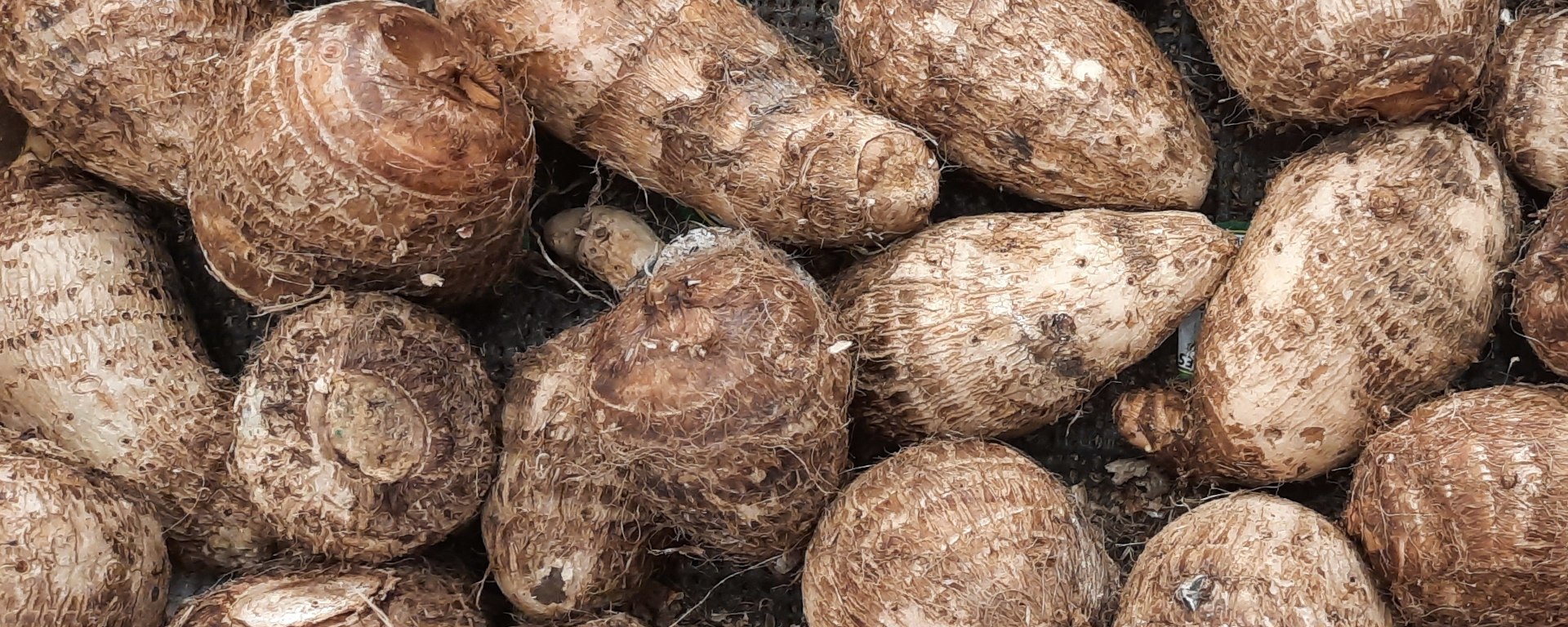What is Taro Root? The taro root is a starchy root type of vegetable that comes from the taro plant Colocasia esculenta (part of the Araceae family). Taro root is part of the tuber family. Cultures from around the world have cultivated and consumed this plant’s leaves and roots (corms) for food since ancient times. Taro roots sometimes go by different names including dasheen, and eddoe.
Taro roots are brown on the outside with visual rings that wrap around the corm. They’re usually white or pale on the inside like a potato. Some have purple speckles and slightly redder shades of purple as you get closer to the skin. The taste (when cooked) can be described as very slightly sweet with a nutty flavor. The texture is gummier than a potato would be. If you’re used to working with yams, than you can imagine a similar texture to that.
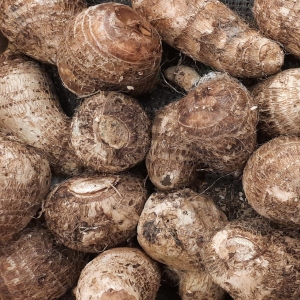 The taro root is easily found regularly in Latin and Asian markets as they are grown in that part of the world but increasingly they are being found more and more in American supermarkets. Despite the word “root” being in the plant’s name.. taro root is a “tuber“.. and the part of the plant that we consume is actually called the corm or cormel.
The taro root is easily found regularly in Latin and Asian markets as they are grown in that part of the world but increasingly they are being found more and more in American supermarkets. Despite the word “root” being in the plant’s name.. taro root is a “tuber“.. and the part of the plant that we consume is actually called the corm or cormel.
The taro plant is toxic and should never be eaten raw and whether you’re eating the corms, roots or leaves, the vegetable and it’s leaves should always be cooked. Taro is fairly easy to grow and will thrive in moist environments found in warm tropical regions. The taro root is packed with fiber and nutrition and makes an excellent addition to a person’s diet if properly prepared.
Can you eat taro root raw?
No. Taro in it’s raw form is toxic and should never be consumed raw whether we’re talking about the leaves, corms, or roots. In fact, just handling taro root in it’s raw form can have negative effects like skin irritation so wearing gloves is a good idea and recommended.
The culprits are little oxalic acid in crystalline form. Those that consume taro root raw complain of mouth irritation, numbing, burning, and itchy skin if handling them.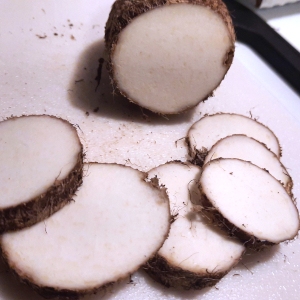
Always cook taro root to help negate the toxic effects. Changing the water during the process is a big plus as well. They can be prepared much in the same way as a potato and must be peeled (recommended to do so with gloves).
In the absence of gloves protecting your hands from the oxalic acid crystals, you can rub some cooking oil on your hands and that may help. However, be forewarned that the taro root is already slippery when peeled.
The leaves of the taro are are also edible and also just as toxic. Prepare the taro leaves the same way you would prepare spinach leaves and you’ll find the texture is very similar to that.
How do you prepare and eat taro root?
Taro root must be cooked first and foremost. Taro root must also be cleaned and peeled before cooking. It can be cooked in several ways and is done so much in the same way you would prepare and eat a potato or other root vegetables. Taro root should be peeled first and then you can cut and cook them. I will usually peel them under water to avoid all the stickiness as they do get slimey.
They can be roasted, boiled, simmered, mashed and fried. For instance, you can boil and mash taro root the same as you would a potato or even a sweet potato or turnips. The texture of taro root tends to be on the “gummier” side. After all, Hawaiian poi is simply mashed tarot root.. served sometimes plain.. or sometimes as a side dish. When eating taro root mashed, I will pair it with celery root or cauliflower to bring down the gummy feel of the taro.
An excellent way to substitute for potatoes in any dinner. You can cut taro root into chips, chunks, slices or cubes.. steam them and salt them. Experiment with all kinds of seasonings, the same as you would any other root vegetables. Grate them up and add them to pancake or crepe batter.
Is taro root a vegetable?
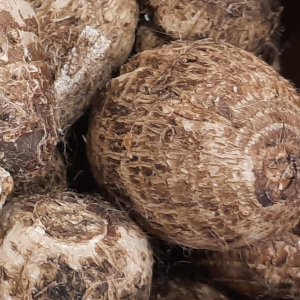 Yes, taro root is a vegetable. Specifically, taro is part of the tuber family. The term “root” here actually refers to the fleshy underground stem of the plant (a tuber). Other vegetables that fall under this category would be the potato, radish, cassava, turnip, carrots, beets and the yam.
Yes, taro root is a vegetable. Specifically, taro is part of the tuber family. The term “root” here actually refers to the fleshy underground stem of the plant (a tuber). Other vegetables that fall under this category would be the potato, radish, cassava, turnip, carrots, beets and the yam.
There are more tuber examples to be sure. Not all tubers are toxic like the taro plant is.
Many tubers can be eaten raw like carrots and potatoes.. where as taro root has to be cooked in some way.
Is taro root good for you?
Once taro root is prepared and cooked correctly, there can be many health benefits to adding taro root to your diet. Besides being high in fiber, taro root has a low glycemic index which makes them good candidates for diabetics who are looking for such foods. Nutritional data shows their packed with manganese, potassium, and anti-oxidants and are full of resistant starches. These are starches that are hard to digest by the body and can promote a healthy gut, prevent diseases, while helping to promote weight loss.
Diets rich in resistant starches and high in fiber tend to boost levels of short-chain fatty acids and oddly enough people suffering from Ulcerative Colitis, among other bowel irritability disorders, tend to be low in these short-chained fatty acids. Adding foods rich in these resistant starches don’t break down that easy and ferment as they pass through you. This fermentation promotes the growth of GOOD bacteria in your gut and helps to maintain a good pre-biotic and pro-biotic environment for your gut biome.
As with anything, if you feel you’re having negative side effects from eating something you should stop eating it. Some people, who have discomfort passing some foods high in fiber, may experience this same discomfort when eating taro root. If you accidentally ingest taro root raw and uncooked, you may experience any number of symptoms related to the toxicity of the taro plant ranging from abdominal discomfort to kidney stones.
Handling and peeling a taro root without gloves may be enough for some people to react to the toxin. Peeling under water (running or in a bucket), will help mitigate the toxin exposure as well. I have a friend who is sensitive to the toxin and they spray their hands with cooking oil before handling taro and that works great for them.
How do you store taro root?
Taro can be stored like any other root vegetable.. in a cool, dry place. A dark place is good idea too as these are root vegetables and my own experience has shown me that given enough time and the right environment, taro will start to grow a few points out the side or a root out the bottom.
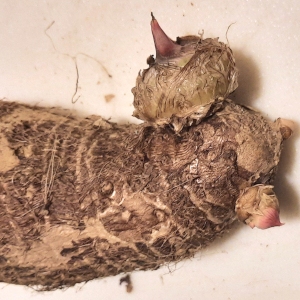 Taro are different than some other root vegetables such as potatoes. Taro tends to soften faster in the same amount of time as a potato and needs to be eaten quicker.
Taro are different than some other root vegetables such as potatoes. Taro tends to soften faster in the same amount of time as a potato and needs to be eaten quicker.
When taro root starts to go bad they will start to get soft and the skin will give when you apply a small amount of pressure to the outside. You will leave visible indentations to the outside skin and feel the give. Throw it away.. or don’t buy that particular taro root if your in the market.
If kept for a long time you may find your taro root hasn’t finished growing. This too can be thrown away and is likely soft to the touch in areas.

